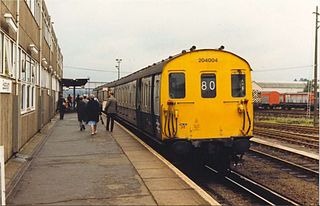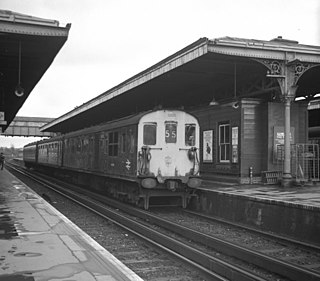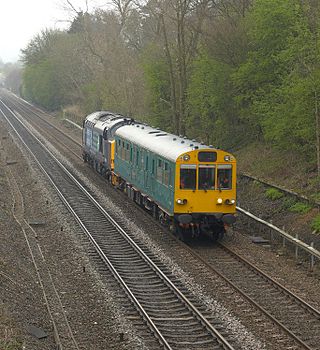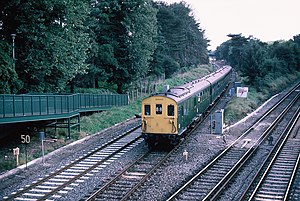
The British RailClass 411 (4CEP) electric multiple units were built at Eastleigh works from 1956–63 for the newly electrified main lines in Kent. These units, which used a British Railways Mark 1 bodyshell, were based on the earlier Southern Railway 4 COR design, built in 1937. Variants of the class 411 design included the class 410 and class 412 4 BEP units, which contained a buffet car in place of a standard trailer. They were later used on services in Sussex and Hampshire; following the privatisation of British Rail in 1995, the units were used by the Connex South Central, Connex South Eastern and South West Trains franchises. They were replaced by Juniper, Desiro, and Electrostar units. The fleet's lifespan was 49 years. These units are the longest-lived BR Mark 1 EMUs.

The British Rail Class 73 is a British electro-diesel locomotive. The type is unusual in that it can operate from the Southern Region's 650/750 V DC third-rail or an on-board diesel engine to allow it to operate on non-electrified routes. This makes it very versatile, although the diesel engine produces less power than is available from the third-rail supply so the locomotives are rarely operated outside of the former Southern Region of British Rail. It is one of the first bi-mode locomotives ever built. Following the withdrawal and scrapping of the more powerful Class 74 bi-mode locomotives in 1977, the Class 73 was unique on the British railway network until the introduction of the Class 88 bi-mode locomotives in 2017. Ten locomotives have been scrapped.

The British Rail Class 205 (3H) diesel-electric multiple units were built by BR at Eastleigh from 1957 to 1962, and in service for 47 years from BR Southern Region to Connex South Central and finally to the Southern franchise. They were eventually replaced by Class 171 Turbostar units.

The British Rail Class 207 (3D) diesel-electric multiple units were built by BR at Eastleigh in 1962. The fleet had a lifespan of 42 years. The Southern Region class 201 to 207 DEMUs are nicknamed 'Thumpers' due to the noise their engine units make.

The British Rail Class 421 (4CIG) electric multiple units were built at BR's Holgate Road carriage works between 1964 and 1972. Units were built in two batches, and were initially introduced on services on the Brighton Main Line. Later units were introduced on services to Portsmouth. These units replaced older Southern Railway-designed units, such as the 5Bel "Brighton Belle" units, and 4Cor units. The fleet's lifespan was 46 years.
A number of different numbering and classification schemes were used for locomotives and multiple units operated by British Railways (BR), and this page explains the principal systems. This section also covers the post-privatisation period, as the broad numbering and classification arrangements have not altered since the break-up of BR.

The British Rail Class 309 "Clacton Express" electric multiple units (EMUs) were built by British Rail (BR) York Carriage Works from 1962–1963. They were initially classified as Class AM9 before the introduction of TOPS. These units were the first express 25 kV alternating current (AC) units to be built by British Rail and were their first EMUs capable of 100 mph.

The British Rail TC multiple units were unpowered fixed formations of 3 or 4 carriages with a driving position at each end of the set, converted by BR's Holgate Road carriage works from locomotive-hauled Mark 1 carriages in 1966–1967 and 1974. The units built on experience gained from the prototype 6TC unit. In time the 3 car units were reformed into four car units to match the rest of the fleet and later classified as Class 442. This was later changed to Class 491, under which they spent the majority of their working lives. Shortly before withdrawal they were reclassified Class 438 and the units were renumbered to 8001-8034.

The British Rail Class 202 diesel-electric multiple units were built from 1957-58 at Eastleigh and Ashford Works. These units were built to work the London Charing Cross to Hastings services. Several tunnels along the route had restricted clearance, meaning that these units were built with a narrow body profile. Similar to the Class 201 they were built to the longer BR Mk1 standard and therefore had 288 seats compared to the 242 (200+42) of the 6S units.

The British Rail Class 204 designation has been used twice for two similar types of diesel-electric multiple units.

The Hastings line is a secondary railway line in Kent and East Sussex, England, linking Hastings with the main town of Tunbridge Wells, and London via Tonbridge and Sevenoaks. Although primarily carrying passengers, the railway also serves a gypsum mine which is a source of freight traffic. Southeastern Trains operates passenger trains on the line, and it is one of their busiest lines.

The British Rail Class 201 six-car diesel-electric multiple units (DEMUs) were built in 1957–1958 at Eastleigh and underframes were built at Ashford.

The British Rail Class 432 (4-REP) electric multiple unit passenger trains were built by BR at York Works from 1966 to 1967 and in 1974. The units were built to power the TC trailer units on services on the South West Main Line. Fifteen four-car units were eventually built. The motor coaches were new build, but the trailers were converted from Mk1 hauled stock. They were initially classified as Class 441 and numbered 3001–3015. This was later changed to Class 430, under which they spent the majority of their working lives. Shortly before withdrawal they were reclassified Class 432 and the units were renumbered as 2001–2015. The fleet had a lifespan of 26 years.

British Rail Class 416 (2-EPB) was a class of third-rail electric multiple units in service between 1953 and 1995. They were intended for inner suburban passenger services on London's Southern Electric network. There were two subclasses of Class 416: Class 416/1 to an SR design on salvaged 2-NOL underframes, built between 1953 and 1956, and Class 416/2 based on a British Railways Mark 1 coach design.

The British Rail Class 206 or 3R was a type of Diesel-electric multiple unit (DEMU), introduced in 1964. They were not 'built' as such but rather re-formed from Class 201 and EPB vehicles for use on Reading-Redhill-Tonbridge services. Six three-car sets were created, numbered 1201-1206.

The GE U20C diesel-electric locomotive was introduced by GE Transportation Systems as an export model in 1964. It was powered by the 8-cylinder 7FDL-8 engine. This locomotive is used worldwide with many variations and modifications. Different engines may be used, e.g. 7FDL8 and 7FDL12. Like the other members of the Universal series, it can be built to suit all track gauges.
The Hastings Units were three classes of diesel-electric multiple unit which were built by BR(S) in the late 1950s, and operated until the mid-1980s.

975025 Caroline, originally the Southern Region General Manager's Saloon, is an inspection saloon used for rail inspection duties on the railway network in Great Britain, and which has historically been used as a VIP excursion train on several occasions. The saloon carriage is notable for being used as the British Royal Train between London Waterloo and Romsey for the first part of the honeymoon trip following the wedding of Prince Charles and Lady Diana Spencer on 29 July 1981. One year later on 28 May 1982, Caroline was the transport for Pope John Paul II's visit to the United Kingdom between Gatwick Airport and London Victoria station.

Class 201, Class 202 and Class 203 were the TOPS codes for a series of Diesel-electric multiple units built for the Southern Region of British Railways in 1957–86. They were classified by the Southern Region as 6S, 6L and 6B respectively, and known collectively as the Hastings Diesels or Hastings Units. They were built for service on the Hastings Line, which had a restricted loading gauge due to deficiencies in the construction of the tunnels when the line was built between 1845 and 1852. The Hastings Units served from 1957 to 1988, being withdrawn when the Hastings Line was electrified with single-track sections through some of the tunnels.
















